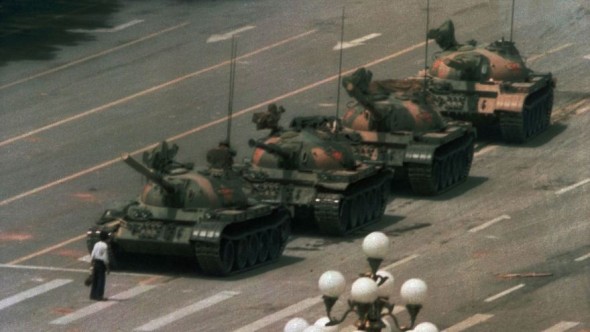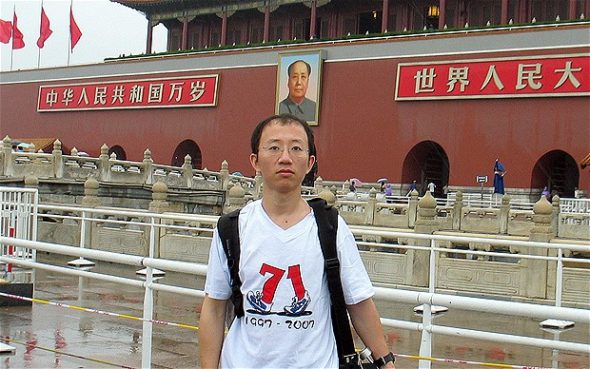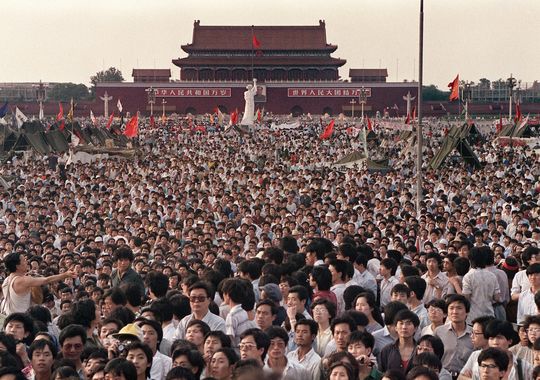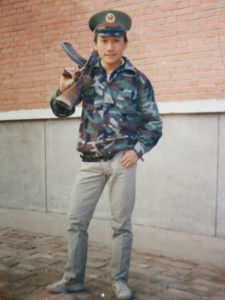Chinese dare recall Tiananmen Square massacre
Daily News Article — Posted on June 3, 2014

A Chinese man blocks military tanks on Changan Avenue, near Tiananmen Square in Beijing, June 5 1989. (AP)
(by Calum MacLeod, USA Today) BEIJING – His name is still unknown, but to many Westerners, the single pedestrian who stopped a line of tanks near Tiananmen Square remains the iconic image of the protest that shook the world 25 years ago. In China, “Tank Man” is a nobody from a non-event.
The anniversary of the bloody crackdown on the 1989 pro-democracy movement – which still defines China for many Americans – will pass Wednesday with…no government acknowledgment of those killed by soldiers after seven weeks of peaceful, student-led protests in Tiananmen Square (the equivalent of the National Mall in Washington, D.C.)
Today, the exact death toll from the protests remains unknown. The crackdown left 500 to 2,600 dead, according to Tiananmen Square, 1989: The Declassified History, published by the George Washington University’s National Security Archive. China’s official death toll is 246.
The pro-democracy movement and massacre are not even taught in Chinese schools, and images and information about the event are scrubbed from the Internet.
“Young people have very little idea what happened in 1989 and very little curiosity or interest,” says Louisa Lim, an NPR correspondent. In four top Beijing colleges, just 15 out of 100 students shown the Tank Man photo last year could identify it, says Lim, author of China, The People’s Republic of Amnesia, which will be published Wednesday. While many Chinese youth are tech-savvy enough to evade China’s Internet restrictions, “they have learned that politics is dangerous and it’s best to steer clear,” she says.
Those who do dare speak about the crackdown face arrest. In the weeks leading up to the anniversary, Amnesty International says, dozens of activists have been detained. Others have been placed under house arrest or reported missing.
“The response by the Chinese authorities to the 25th anniversary has been harsher than in previous years, as they persist with trying to wipe the events of 4 June from memory,” Salil Shetty, secretary-general of Amnesty International, said in a statement.

Hu Jia
Still, Hu Jia, 40 – a dissident under house arrest for the past three months who, at 15, pushed buses into the road near his home to stop tanks headed for the square – is calling on Chinese citizens to mark the anniversary by visiting the square Wednesday wearing black clothes. Some wore the color last year, says Hu – who risks jail time for organizing others to protest, a major crime in the party’s eyes – convinced officials can’t ban black without being forced to explain why.

Chinese people gather on Tiananmen Square demanding democracy despite martial law in Beijing on on June 2, 1989. (AFP/Getty Images)
“The authorities can’t change my understanding and my memories,” he says. “It’s a very small number, but more young people are waking up and gaining an understanding than before.”
China’s Internet [Baidu Baike] remains “an information prison to keep the truth out,” Hu says, but he uses software to evade the “Great Firewall of China” and push online campaigns such as “Return to Tiananmen,” which launched a year ago. [Google services have been disrupted in China since last week and the Chinese government already blocks Facebook, Twitter and Google’s YouTube.]
“The authorities use terror to shut people’s mouths,” Hu says, “but they are not God, and can’t make everything disappear.”
‘THEY’RE AFRAID OF US’

The last picture taken of Wang Nan shows him attending compulsory military camp, where he was given a standard-issue military belt. Because he was wearing it when he died, his corpse was misidentified as a soldier’s and sent to the hospital, instead of being cremated as an unidentified rioter, so his parents were able to claim it.
When Zhang Xianling needs groceries, she passes three state security personnel stationed to watch her ninth floor apartment. Another four wait downstairs, along with a police car she must take to reach the market or go anywhere.
That’s all because Zhang, 76, pursues justice for her son, Wang Nan, a student killed by an army bullet a quarter of a century ago when he was just 19.
Authorities prevent Zhang from meeting journalists or other Tiananmen Mothers, a group she co-founded in 1989 for relatives of those who died in the massacre. Ding Zilin, a spokesperson for the group, has been placed under house arrest, according to Amnesty International.
“At first we just did this for our kids, then we came to realize it’s a problem of our country’s political system,” Zhang says.
Despite years of intimidation and harassment – to stop Zhang from mourning her son, a surveillance camera is trained on the spot where he died – the Tiananmen Mothers persist in demanding a public investigation, a list of the dead and punishment for those responsible.
“They’re afraid of us, because we grasp the truth,” she says. “They killed so many people, this is not a government that takes responsibility. Justice is in our hands.”
For the government, that truth is that the protest was a “counterrevolutionary rebellion.” Hu despairs at such enforced ignorance.
“School textbooks lack the two characters 6/4; at most there’s one sentence referring to a ‘political disturbance,’ as they’ve shrunk it into a small-sounding case,” he says.
Today, Chinese authorities maintain that their decisive action ensured years of spectacular economic growth, transforming the nation into the world’s second-largest economy, one that is gaining fast on the U.S.
That notion has achieved wide acceptance in China, NPR’s Lim says. “People have largely believed this, as their lives have got better, and people have wanted to believe there was no other way,” she says.
In 1989, protesters called for a less corrupt, fairer government that could continue under Communist party rule. But the party’s leadership saw a “near-death experience,” says Rana Mitter, a Chinese history and politics expert at Oxford University. As a result, the movement’s key influence was “making the party determined that whatever else happens, it must maintain a firm grip on power.”
Authorities now spend more on internal security – including suppressing dissidents – than external from “a great fear that the political settlement is very fragile,” Mitter says. Over the past 25 years, the ruling party has remained “alarmed by the prospect of more liberalization and understood the importance of economic growth to cement its legitimacy.”
In the past year, Chinese authorities have crushed a loose network of activists called the New Citizens Movement, a group that aims to expose the official corruption that was also a major focus of the 1989 demonstrations. Current party chief Xi Jinping, who has tightened Internet controls, leads a wide-ranging anti-corruption campaign, but makes no move toward creating the independent media, judiciary and anti-corruption agency China requires to tackle graft.
“There’s a crushing sense of disappointment that we see every time a new set of leaders comes into power,” says Lim. “People had hoped that Xi Jinping maybe would be a closet reformer, but there’s a sense now that we are further away than ever before to any re-evaluation of 1989.”
‘TRUTH WILL OVERCOME THEIR LIES’
…Amid the despair and the strictest surveillance since 1989, the Internet offers hope as awareness is raised on social media, says Zhang, who will mourn her son at home.
“The Communist Party has such a long experience of brain-washing and telling lies, and they do it very well,” says Zhang. “I used to believe them. The party can fool many people, but the truth will overcome their lies.”
Reprinted here for educational purposes only. May not be reproduced on other websites without permission from USA Today. Visit the website at usatoday .com.
Background
Massacre at Tiananmen: June 4, 2009 is the Twentieth anniversary of the crackdown on democracy at Tiananmen Square: (from bobsonwong.com/dfn/focus/china/tian10.htm)
- In April 1989, Hu Yaobang, the former reform-minded Communist Party general secretary [of China], died. Hu had been purged from the party leadership in 1987 [for his reform ideas], and Zhao Ziyang replaced him as general secretary.
- Hundreds of thousands of students mourned Hu’s death by staging large demonstrations in Tiananmen Square in Beijing, the country’s capital. Led by people like Beijing University student Wang Dan, the students demanded an end to government corruption, greater personal and political freedom, and improved conditions in China’s colleges.
- The turning point came in May, when Soviet President Mikhail Gorbachev visited China. International journalists who came to Beijing to cover the summit beamed to the rest of the world live images of thousands of students occupying Tiananmen Square and going on a hunger strike.
- Behind the scenes, Chinese officials argued over what they should do. Moderates such as Zhao Ziyang advocated peaceful dialogue with the students. Hardliners such as Chinese senior leader Deng Xiaoping, who led the country through an economic reform process that limited political change, insisted on using military force to crack down on the demonstrations.
- The hardliners eventually prevailed. As demonstrations spread to other cities in May, martial law was declared. On the night of June 3-4, Chinese army troops moved into Tiananmen Square and dispersed crowds, killing and imprisoning thousands. Student demonstration leader Wang Dan was arrested and spent several years in prison before being paroled and exiled to the United States. Human rights groups estimate that hundreds of people detained after protests are still in custody.
- The Chinese government continues to refuse to acknowledge any wrongdoing. In the days before the ten-year anniversary, China stopped CNN from broadcasting into Beijing and arrested several dissidents.
